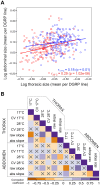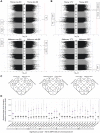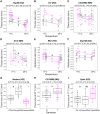Genetic basis of thermal plasticity variation in Drosophila melanogaster body size
- PMID: 30256798
- PMCID: PMC6175520
- DOI: 10.1371/journal.pgen.1007686
Genetic basis of thermal plasticity variation in Drosophila melanogaster body size
Abstract
Body size is a quantitative trait that is closely associated to fitness and under the control of both genetic and environmental factors. While developmental plasticity for this and other traits is heritable and under selection, little is known about the genetic basis for variation in plasticity that can provide the raw material for its evolution. We quantified genetic variation for body size plasticity in Drosophila melanogaster by measuring thorax and abdomen length of females reared at two temperatures from a panel representing naturally segregating alleles, the Drosophila Genetic Reference Panel (DGRP). We found variation between genotypes for the levels and direction of thermal plasticity in size of both body parts. We then used a Genome-Wide Association Study (GWAS) approach to unravel the genetic basis of inter-genotype variation in body size plasticity, and used different approaches to validate selected QTLs and to explore potential pleiotropic effects. We found mostly "private QTLs", with little overlap between the candidate loci underlying variation in plasticity for thorax versus abdomen size, for different properties of the plastic response, and for size versus size plasticity. We also found that the putative functions of plasticity QTLs were diverse and that alleles for higher plasticity were found at lower frequencies in the target population. Importantly, a number of our plasticity QTLs have been targets of selection in other populations. Our data sheds light onto the genetic basis of inter-genotype variation in size plasticity that is necessary for its evolution.
Conflict of interest statement
The authors have declared that no competing interests exist.
Figures




Similar articles
-
Genetic basis of variation in thermal developmental plasticity for Drosophila melanogaster body pigmentation.Mol Ecol. 2024 Mar;33(6):e17294. doi: 10.1111/mec.17294. Epub 2024 Feb 16. Mol Ecol. 2024. PMID: 38366327
-
Population-based resequencing of experimentally evolved populations reveals the genetic basis of body size variation in Drosophila melanogaster.PLoS Genet. 2011 Mar;7(3):e1001336. doi: 10.1371/journal.pgen.1001336. Epub 2011 Mar 17. PLoS Genet. 2011. PMID: 21437274 Free PMC article.
-
Genetic Architecture of Micro-Environmental Plasticity in Drosophila melanogaster.Sci Rep. 2015 May 6;5:9785. doi: 10.1038/srep09785. Sci Rep. 2015. PMID: 25943032 Free PMC article.
-
Mutations and quantitative genetic variation: lessons from Drosophila.Philos Trans R Soc Lond B Biol Sci. 2010 Apr 27;365(1544):1229-39. doi: 10.1098/rstb.2009.0315. Philos Trans R Soc Lond B Biol Sci. 2010. PMID: 20308098 Free PMC article. Review.
-
Charting the genotype-phenotype map: lessons from the Drosophila melanogaster Genetic Reference Panel.Wiley Interdiscip Rev Dev Biol. 2018 Jan;7(1):10.1002/wdev.289. doi: 10.1002/wdev.289. Epub 2017 Aug 22. Wiley Interdiscip Rev Dev Biol. 2018. PMID: 28834395 Free PMC article. Review.
Cited by
-
Genomics of Developmental Plasticity in Animals.Front Genet. 2019 Aug 7;10:720. doi: 10.3389/fgene.2019.00720. eCollection 2019. Front Genet. 2019. PMID: 31481970 Free PMC article. Review.
-
Genetic variation of morphological scaling in Drosophila melanogaster.Heredity (Edinb). 2023 May;130(5):302-311. doi: 10.1038/s41437-023-00603-y. Epub 2023 Mar 6. Heredity (Edinb). 2023. PMID: 36878946 Free PMC article.
-
Multidimensional plasticity in the Glanville fritillary butterfly: larval performance is temperature, host and family specific.Proc Biol Sci. 2020 Dec 23;287(1941):20202577. doi: 10.1098/rspb.2020.2577. Epub 2020 Dec 16. Proc Biol Sci. 2020. PMID: 33323089 Free PMC article.
-
Within-population variation in body size plasticity in response to combined nutritional and thermal stress is partially independent from variation in development time.J Evol Biol. 2023 Jan;36(1):264-279. doi: 10.1111/jeb.14099. Epub 2022 Oct 8. J Evol Biol. 2023. PMID: 36208146 Free PMC article.
-
The genetic architecture underlying body-size traits plasticity over different temperatures and developmental stages in Caenorhabditis elegans.Heredity (Edinb). 2022 May;128(5):313-324. doi: 10.1038/s41437-022-00528-y. Epub 2022 Apr 5. Heredity (Edinb). 2022. PMID: 35383317 Free PMC article.
References
-
- Kingsolver JG, Huey RB. Size, temperature, and fitness: three rules. Evol Ecol Res. 2008;10:251–268.
-
- Peters RH. The ecological implications of body size. Cambridge: Cambridge University Press; 1986. 329 p.
-
- Smith FA, Lyons SK. Animal body size: linking pattern and process across space, time, and taxonomic group. University of Chicago Press; 2013. 267 p.
Publication types
MeSH terms
LinkOut - more resources
Full Text Sources
Other Literature Sources
Molecular Biology Databases

